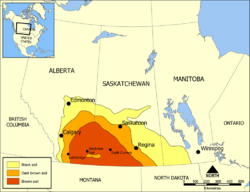Canadian Prairies
[4] Physical or ecological aspects of the Canadian Prairies extend to northeastern British Columbia, but that area is not included in political use of the term.[14] Approximately 72% of tornadoes in Canada are seen across the prairies[15] due to the capability of summer thunderstorm precipitation to mechanically mix with the air adjacent to the relatively flat surface of the region.Mixed prairie is more common and is part of the dry interior plains that extend from Canada south to the U.S. state of Texas.Though widespread in southern Saskatchewan and southeastern Alberta, because of extensive cattle grazing, it is estimated that only 24% of the original mixed prairie grassland remains.[30] The southwestern Canadian prairies, supporting brown and black soil types, are semi-arid and highly prone to frequent and severe droughts.Aspen parkland covers the area; The long daylight hours in this region during the summer are an asset despite having an even shorter growing season than central Alberta.[3] Agriculture consisting of livestock (cattle and sheep), cultivating crops (oats, canola, wheat, barley), and production of oil.In the 1950s-1970s, the explosion of oil production increased the worth of Alberta, allowing it to become the "nation's richest province" and Canada one of the top petroleum exporters in the world.It was through the steady economic growth that followed this explosion that the prairies region began to switch from an agriculture-based job sector to one with services included.[5] Saskatchewan, in particular, in the early 20th century grew economically due to the Canadian agricultural boom and produce large crops of wheat.The first Europeans to see the Prairies were fur traders and explorers from eastern Canada (mainly present-day Quebec) and Great Britain via Hudson Bay.This can be attributed partially to the massive influx of American settlers who began to migrate to Alberta (and to a lesser extent, Saskatchewan) in the late 1880s because of the lack of available land in the United States.These political movements (both of the left and right) tend to feed off of well established feelings of Western alienation, and each one represents a distinct challenge to the perceived Central Canadian elite.




Prairie (disambiguation)FrenchEcoregionHartney, ManitobaAlbertaSaskatchewanManitobaCanadaWestern CanadaGreat PlainsgrasslandsplainslowlandsforeststopographyInterior PlainsBritish Columbiatemperate grasslandshrublandprairienorthern mixed grasslandsPrairies Ecozonenorthern tall grasslandsEdmontonMinnesotaboreal forestKöppen climate classificationregioncontinental climatesarid climateagricultural productiontornadoesLethbridgeCalgaryMedicine HatGrande PrairieReginaSaskatoonPrince AlbertBrandonWinnipegGeography of CanadaCanadian ShieldWestern CordilleraHudson BayGimli, ManitobaLake Winnipegtallgrass prairiemixed grass prairiefescuenorthern short grasslandsRed River ValleyPalliser's Triangleblack soilsemi-aridCheadleaspen parklandwild ricePeace RegionCensus metropolitan areasCanadian 2021 Censusoil productionAgricultureFort McMurrayFirst NationsIndigenous people in Canadafur tradersQuebecGreat BritainMétisworking classblock settlementsBritishUkrainianGermanScandinavian CanadianbadlandscowboyRaymond Stampedemusic of Canada's Prairie ProvincesWinnipeg General Strike of 1919general strikeWestern alienationCentral CanadianConservative Party of CanadaNew Democratic Partyseats at the federal levelLiberal Party of CanadaManitoba Liberal PartyDominion Land SurveyHigh Plains (United States)List of regions of CanadaLlano EstacadoNatural Resources ActsShortgrass prairieEcozones of CanadaBibcodeEnvironment CanadaThe Globe and MailBibliography of Saskatchewan historyBibliography of Alberta historyHistory of ManitobaWayback MachineProQuest Dissertations & ThesesManitoba EscarpmentSaskatchewan PlainMissouri CoteauCypress HillsRocky Mountain FoothillsBeaver HillsQu'Appelle ValleyCanadian aspen forests and parklandsMontana valley and foothill grasslandsWorld Heritage SitesHead-Smashed-InDinosaurWriting-on-Stone / Áísínai'piUNESCO Biosphere ReservesRedberry LakeRiding MountainElk Island Waterton LakesHistoric SitesBar U RanchBatocheCypress Hills Massacre